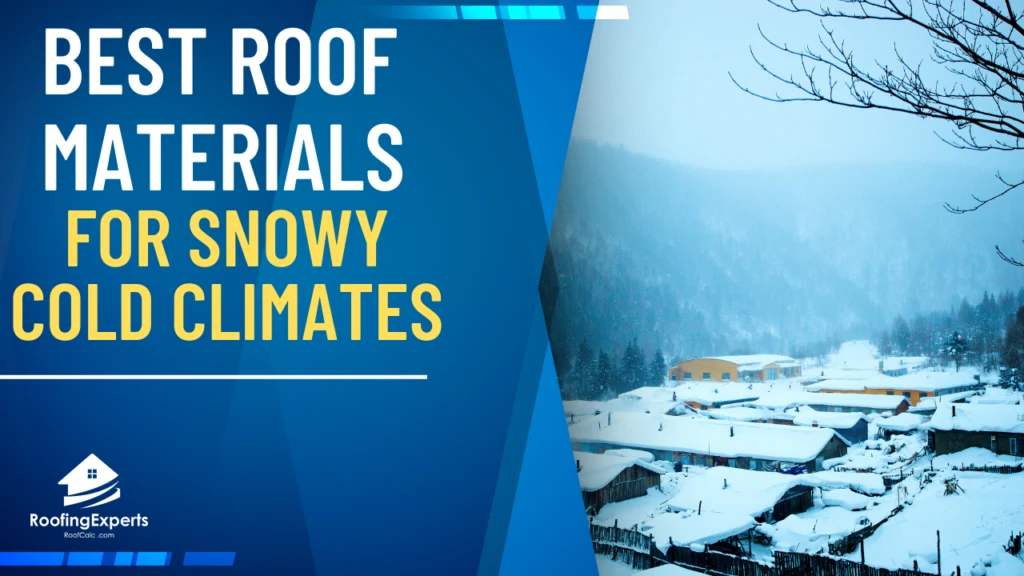
Are you a homeowner in a snowy and cold climate, wondering what type of roof material will best withstand the harsh winter weather? Look no further!
In this article, we’ll explore the top roof materials that can withstand heavy snow loads, resist ice dam formation, and maintain their durability and performance even in frigid temperatures.
Whether you’re building a new home or considering a roof replacement, this guide will help you choose the best roofing material to keep you and your family warm and safe all winter long.
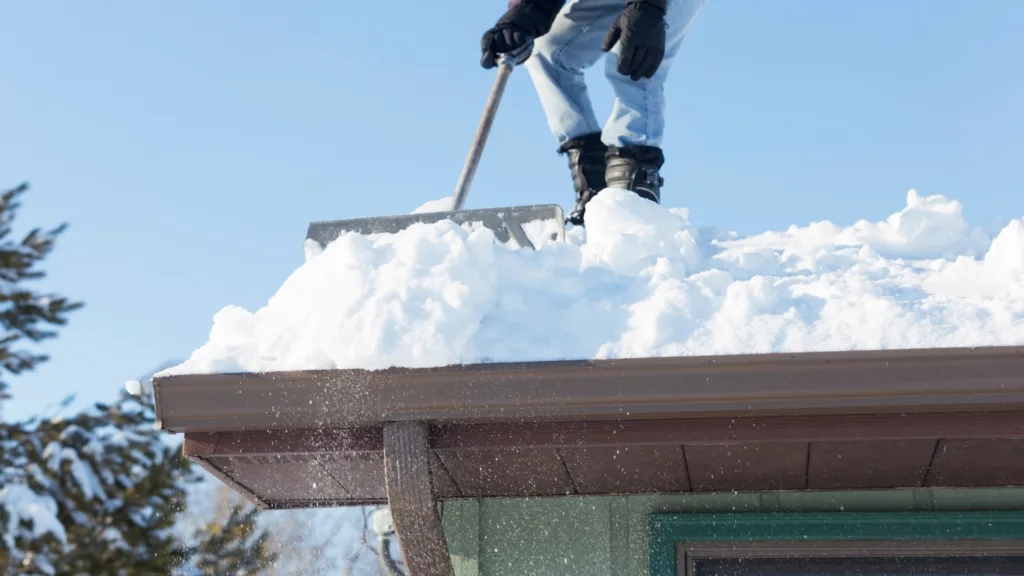
Factors to Consider in Cold Climates
When choosing the best roofing materials for snowy, cold climates, there are several factors to consider. In this section, we’ll discuss the aspects of a roof that should be tailored to withstand harsh winter conditions.
Snowfall and Weight
Heavy snowfall is common in cold climates, and your roof needs to handle the added weight. When selecting a roofing material, consider its ability to support the snow and prevent it from accumulating.
Roofs with steeper pitches can help facilitate snow sliding off, while some materials like metal are better at preventing snow build-up.
Temperature Fluctuations
Cold temperatures can cause materials to contract, while warm temperatures cause them to expand. This contraction and expansion can lead to cracks and leaks in your roof.
For this reason, it’s essential to select a roofing material that can withstand these fluctuations, such as metal roofing or slate tiles.
Wind and Hail Resistance
Strong winds and hailstorms can cause significant damage to your roof. To protect your home, choose roofing materials that are resistant to these extreme weather events.
For instance, metal and asphalt shingles are known for their wind and hail resistance, with metal being the most durable.
Energy Efficiency
Energy efficiency is a crucial factor in choosing a roofing material for cold climates. Your roof should have insulative properties that help keep your home warm, lower your energy bills, and reduce ice build-up.
Some materials, like slate, concrete, or clay tiles, have natural insulating abilities, while others may require additional insulation.
When selecting the best roofing materials for cold climates, it’s essential to consider these factors:
- Snowfall and weight handling
- Ability to withstand temperature fluctuations
- Wind and hail resistance
- Energy efficiency
By taking these aspects into account, you can provide your home with the protection and comfort it needs to endure winters in colder climates.
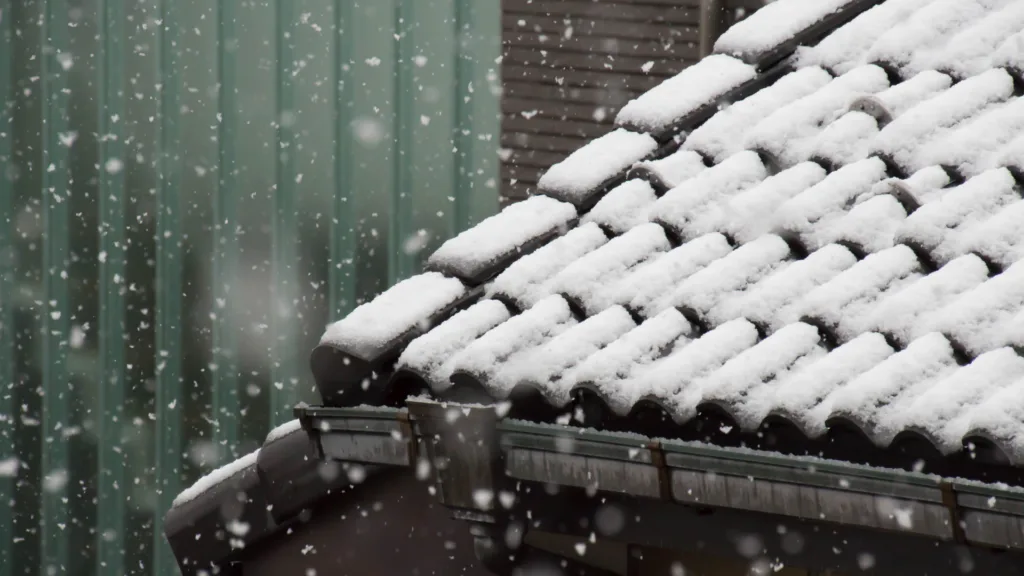
Best Roof Materials for Snowy Climates
When it comes to choosing the best roofing materials for snowy climates, you need to consider several factors like durability, insulation, and affordability.
In this section, we will discuss four types of roofing materials that are suitable for such conditions:
Metal Roofing
Metal roofs are highly durable and can withstand heavy snowfall. They’re typically made of galvanized steel or tin, which provides excellent protection against harsh weather conditions.
Additionally, metal roofs are fire-resistant, making them a safe choice in areas prone to wildfires. Some advantages of metal roofing include:
- Long lifespan (upwards of 50 years)
- Resistant to wind, rain, and snow
- Low maintenance and repair costs
However, metal roofs can be more expensive than other materials, so it’s essential to weigh the benefits against the initial investment.
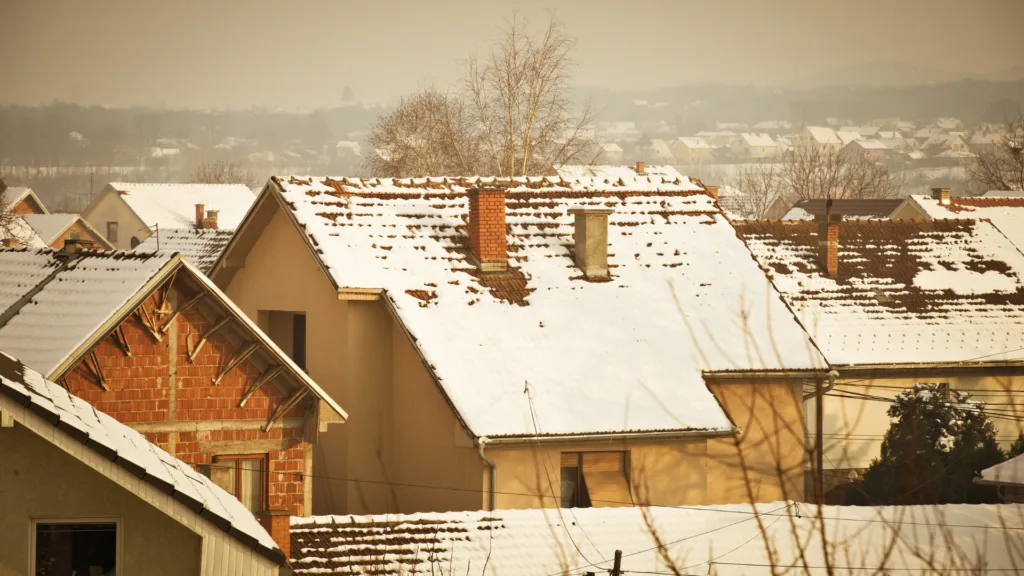
Slate Roofing
Slate is a natural stone roofing material known for its durability and resistance to harsh climates. This heavy material can handle the weight of snow and withstand strong winds. Some benefits of slate roofing include:
- Exceptional longevity (100+ years)
- Low maintenance requirements
- Fire and water-resistant
Although slate roofing offers excellent protection against snow and cold temperatures, it can be more costly than other materials and may require professional installation.
Synthetic Shingles
Synthetic shingles are a more affordable alternative to natural slate or clay tiles. These shingles are made from a blend of materials, such as fiberglass and asphalt, providing a Class 4 impact rating for added durability.
Some advantages of synthetic shingles include:
- Cost-effective compared to natural stone options
- Lightweight and easy to install
- Good resistance to snow, wind, and water
It’s crucial to choose high-quality synthetic shingles, as lower-quality options may not provide the same level of protection against cold climates.
Fiberglass Asphalt Shingles
Fiberglass asphalt shingles are a popular choice for cold climates due to their affordability and versatility. These architectural shingles can provide adequate insulation and protection from snow and harsh weather.
Some benefits of fiberglass asphalt shingles include:
- Can last 20-30 years with proper maintenance
- Class 4 impact rating for better protection
- Affordable and easy to install
To ensure the best performance, we recommend selecting high-quality shingles and investing in professional installation.
In summary, while there’s no one-size-fits-all answer, the roofing materials discussed above all possess qualities that make them ideal for snowy climates.
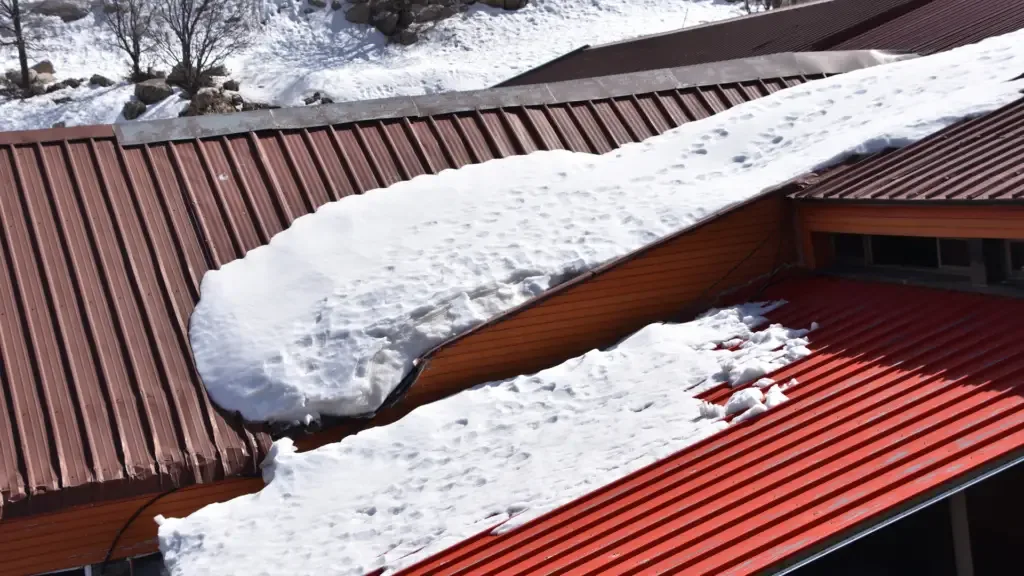
Preventing and Addressing Common Problems
Ice Dams
Ice dams can be a major concern for homeowners in cold climates like Colorado and Minnesota, where heavy snowfall and melting snow can lead to the formation of ice on your roof, especially along the edges and gutters.
These ice dams can cause leakage, resulting in water damage to your home’s interior. To prevent ice dams:
- Ensure your attic is properly insulated and ventilated, promoting energy efficiency and minimizing heat buildup.
- Install heated cables along the edge of your roof and gutter system to melt snow and ice before it accumulates.
- Remove excess snow from your roof using a roof rake.
If you are already experiencing ice dams, consider hiring a professional to remove them safely and assess the need for repairs.
Roof Leaks
Roof leaks can occur due to extreme weather, snowstorms, and melting snow. To protect your home from leaks, follow these steps:
- Regularly inspect your roof, gutters, and downspouts for damage or debris.
- Replace or repair damaged shingles, flashings, or seals around vent pipes and chimneys.
- Consider installing a waterproof membrane under your roofing materials to serve as an additional layer of protection.
Should you encounter a roof leak, address the issue immediately to minimize repair costs and damage to your home’s interior.
Structural Damage
Heavy snow and ice accumulation can lead to structural damage or even collapse, especially for roofs in regions with frequent snowstorms. Here’s how to reinforce and protect your roof’s structural support:
- Ensure your roof is built to handle the weight load of snow and ice in your geographic area.
- Install snow guards or a snow retention system to prevent snow from sliding off the roof and causing damage to gutters, windows, or landscaping.
- Regularly inspect your roof for signs of stress or damage, such as sagging or cracked rafters, and seek professional assistance if any issues are identified.
By being proactive and addressing ice dams, roof leaks, and structural damage, you can protect your home from the harsh impacts of extreme cold weather and snowy climates.
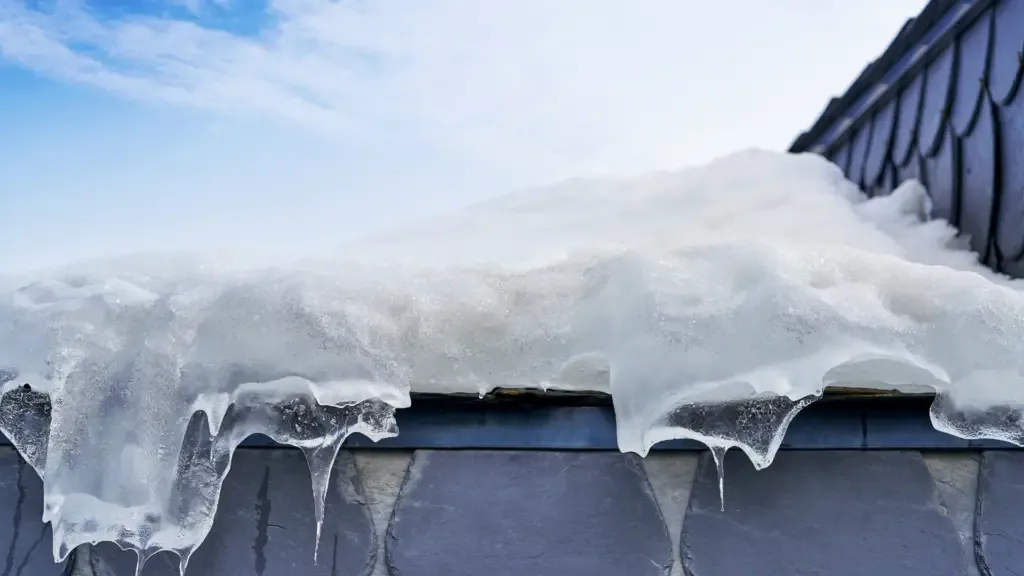
Maintenance and Durability Concerns
Insulation and Ventilation
In colder climates, it’s important to ensure that your roof provides adequate insulation and ventilation. A well-insulated roof helps in trapping heat inside your home, reducing energy costs, and minimizing the risk of ice dam formation.
Attic ventilation, on the other hand, prevents condensation buildup that can lead to mold and rot. Effective insulation and ventilation will help protect your roofing materials from damage caused by temperature swings and moisture.
Repair Costs and Longevity
The longevity and repair costs of your roof will depend on the type of material used. Here are some common roofing materials for snowy and cold climates:
- Slate Tile Roofing: This durable material can last over 100 years with minimal maintenance, but it can be quite costly to install and repair.
- Metal Roofing: Metal roofs are durable and low-maintenance, typically lasting 40-70 years. While installation is more expensive than shingle roofing, repairs tend to be less frequent and less costly.
- Asphalt Shingles: These are a popular choice for many homeowners due to their affordability and ease of installation. Asphalt shingle roofs generally last 20-30 years, but they may require more frequent repairs in colder climates.
- Concrete and Clay Tile Roofing: These materials offer excellent durability and can last 50-100 years, but they can be expensive to install and repair, and their weight may require additional structural support.
Weather and Impact Resistance
Roofing materials for snowy and cold climates should also be able to withstand harsh weather conditions, such as heavy snowfall, hailstorms, and high winds. Here’s how some common materials fare in these conditions:
- Slate Tile Roofing: Extremely weather-resistant, offering protection from heavy snow, hail, and freeze-thaw cycles. However, it can be heavy and may require additional support.
- Metal Roofing: With a Class 4 impact rating, metal roofs are highly resistant to hail and wind damage. They are also lightweight and good at shedding snow, reducing the risk of snow buildup and ice dams.
- Asphalt Shingles: While asphalt shingles can offer decent protection from cold weather, heavy snowfall, and high winds, they are less resistant to hail and may be susceptible to damage in extreme conditions.
- Concrete and Clay Tile Roofing: These materials are also highly weather-resistant but may be susceptible to damage from freeze-thaw cycles or heavy snow buildup due to their weight.
It’s essential to choose a roofing material that offers durability and low maintenance, considering insulation, ventilation, repair costs, and weather resistance.
By selecting the right roofing system for your home in a snowy and cold climate, you can save on energy costs, minimize the need for repairs, and prolong the life of your roof.
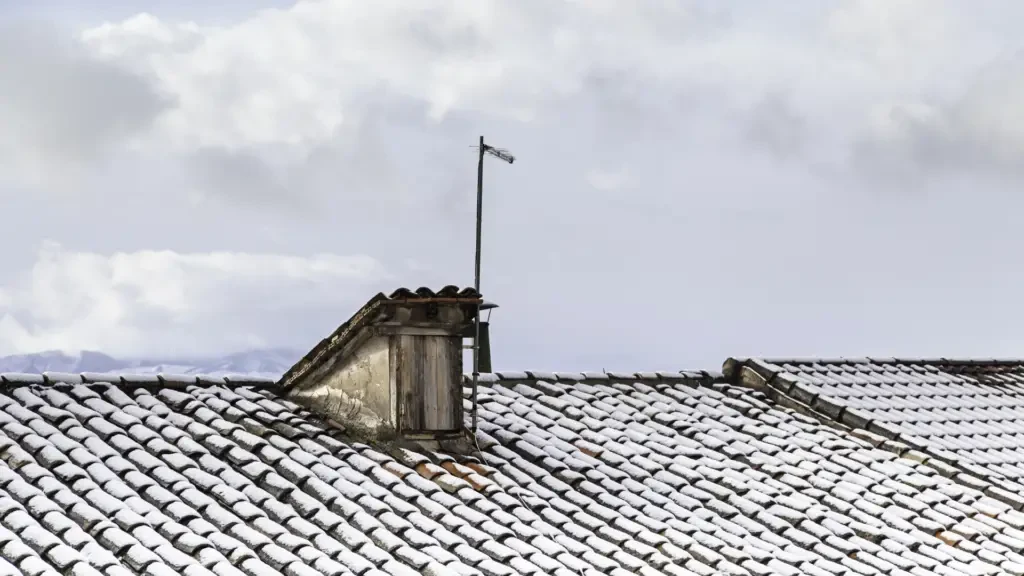
Budget-Friendly Options for a Snowy Climate
When looking for budget-friendly roofing materials that can withstand snowy and cold climates, there are several options to consider. It’s essential to find the right combination of affordability, durability, and energy efficiency for your home.
Fiberglass asphalt shingles are a popular and cost-effective choice. They’re made from a fiberglass base, topped with mineral granules, providing a strong and durable material that can handle the weight of heavy snow.
Not only are they affordable, but they also deliver good insulation, helping to keep your energy costs down in the winter months.
Synthetic slate shingles offer a stylish and climate-resistant alternative. Made from recycled materials, they replicate the appearance of natural slate roofs but at a fraction of the cost.
These shingles are low maintenance and generally energy efficient, making them a budget-friendly option for snowy climates.
Another affordable choice for cold weather roofing is concrete tile roofing. While slightly more expensive than asphalt shingles, concrete roofs provide excellent durability and insulation, lasting longer and requiring less maintenance than other budget-friendly options.
To make concrete roofing more affordable:
- Consider lighter-weight concrete tiles to reduce installation costs.
- Look for locally manufactured tiles, as transportation costs can impact the overall price.
Remember, investing in energy-efficient roofing materials can save you money in the long run by reducing your heating bills. To summarize, here are some budget-friendly roofing options for snowy climates:
- Fiberglass asphalt shingles: Affordable, durable, and energy-efficient
- Synthetic slate shingles: Stylish and made from recycled materials
- Concrete tile roofs: Long-lasting with excellent insulation properties
Consider the specific needs of your home and the local climate to choose the best budget-friendly roofing material for your situation.
Keep in mind that while you may save upfront costs by selecting a more affordable roofing material, ongoing maintenance and durability should also factor into your decision.

